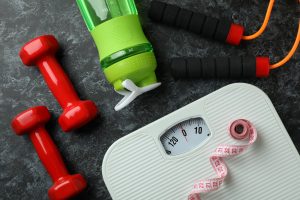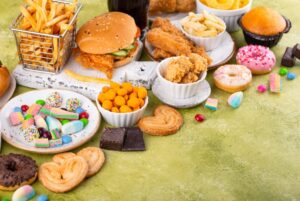When it comes to losing weight, few topics spark as much debate as whether diet or exercise matters more. While both play critical roles in achieving and maintaining a healthy body composition, evidence shows that your nutrition habits have a far greater influence on your success — especially in the beginning. But without exercise, particularly resistance training, your long-term results and overall health can suffer.
The Role of Diet: Why Nutrition Drives 80% of Results
Your daily calorie intake directly determines whether you lose, maintain, or gain weight. As studies published in the National Institutes of Health show, reducing calorie-dense processed foods and prioritizing whole, nutrient-rich meals leads to consistent fat loss. Even simple changes — such as cutting out sugary drinks like flavored coffees or sodas — can make a noticeable difference.
Take, for example, a common seasonal favorite: a grande pumpkin spice latte from Starbucks contains up to 60 grams of sugar, more than twice the daily recommended limit for women and nearly the full limit for men. Drinks like these can easily add 300–400 calories per day, undermining weeks of exercise efforts. For many people, identifying and eliminating these “hidden calories” is the easiest way to begin losing weight without drastic changes.
That’s why diet is often said to account for about 75–80% of your total progress. You can train hard every day, but if your diet is unbalanced — high in sugar, processed carbs, and low in protein — your results will stall. Food quality, calorie balance, and macronutrient ratios form the foundation of all body composition improvements.
Why You Can’t Outrun a Bad Diet
Exercise burns calories, but not nearly as many as most people think. Running a mile might burn 100–150 calories, while a single pastry or coffee can easily double that. This imbalance is why fitness professionals often say, “You can’t outrun a bad diet.” Without dietary control, even high activity levels won’t offset overeating or poor food choices.
However, exercise has benefits that go far beyond calorie burn. When combined with proper nutrition, it accelerates fat loss, strengthens the cardiovascular system, and improves mental health. Still, without adjusting your diet, these benefits won’t translate into the physique or metabolic improvements most people seek.
Why Resistance Training Is Crucial During Weight Loss
When people lose weight through diet alone, a significant portion of that loss comes from muscle mass. This is a problem because lean tissue is metabolically active — it helps your body burn calories even at rest. Losing muscle means slowing down your metabolism, which makes it easier to regain fat once you stop dieting.
Resistance training prevents this. Lifting weights, doing bodyweight exercises, or using resistance bands stimulates muscle retention and growth. Each pound of muscle you build helps increase your resting metabolic rate. Over time, this “expensive tissue” effect makes it easier to maintain a lean physique because your body naturally burns more calories throughout the day.
“Muscle is metabolically expensive — and that’s a good thing. The more lean mass you have, the more calories your body burns just to sustain it.”
Beyond aesthetics, maintaining muscle is essential for healthy aging. Research from the Journal of Cachexia, Sarcopenia and Muscle shows that muscle mass is strongly linked to longevity, insulin sensitivity, and overall vitality. In short: building and preserving muscle may literally extend your life.
Muscle, Glucose, and Longevity: The Metabolic Connection
Muscle tissue acts like a sponge for glucose. When you lift weights or perform other forms of resistance exercise, your muscle cells pull glucose from the bloodstream to use as energy. This process helps stabilize blood sugar levels and improves insulin sensitivity — key factors in preventing type 2 diabetes and metabolic syndrome.
Additionally, resistance training has been shown to increase HDL (the “good”) cholesterol, improve cognitive performance, and enhance functional strength — especially in the legs and core, which are vital for mobility and fall prevention as we age. The link between muscle and longevity is now well documented, and experts increasingly view muscle as a critical biomarker of overall health.
The Problem With Weight Loss Drugs
Weight loss medications have become increasingly popular, but they come with serious trade-offs. While they can suppress appetite and cause short-term fat loss, they also lead to significant muscle loss if not combined with resistance training. Once the medication is discontinued, most users regain the lost weight — and often more — but with less lean tissue than before. This results in a slower metabolism and a higher fat-to-muscle ratio.
For sustainable results, lifestyle-based methods still reign supreme: consistent resistance training, adequate protein intake, and moderate calorie reduction.
Protein: The Key to Preserving Muscle
Protein plays a unique role in the weight loss process. Not only does it support muscle repair and growth, but it also has a high thermic effect — meaning your body burns more calories digesting protein than it does digesting fats or carbohydrates. This “thermogenic advantage” helps increase daily energy expenditure and supports long-term fat loss.
To maintain or build lean mass during a calorie deficit, aim to consume at least 0.8–1.2 grams of protein per pound of body weight, depending on activity level. Focus on lean sources like chicken, fish, eggs, Greek yogurt, and plant-based proteins such as lentils or tofu. Balanced meals combining protein with vegetables and healthy fats help stabilize energy levels and reduce hunger throughout the day.
Exercise and Diet: A Synergistic Approach
While diet may have the bigger influence on the scale, exercise determines the quality of the weight you lose. A person who focuses solely on cutting calories may become “skinny fat” — lighter in weight but lacking muscle definition and strength. On the other hand, combining good nutrition with strength training promotes fat loss while preserving (or even increasing) lean mass, resulting in a fitter, healthier appearance.
Ultimately, the best approach to weight loss isn’t diet or exercise — it’s both. Nutrition determines whether your body gains or loses energy stores, while exercise determines how those changes affect your muscle composition and metabolism.
Practical Steps for Sustainable Results
- Start with small dietary swaps: Replace sugary beverages with water or black coffee, and reduce refined carbs.
- Prioritize protein: Include protein in every meal to support muscle maintenance and appetite control.
- Lift weights regularly: Aim for 2–4 sessions per week focusing on compound movements like squats, presses, and rows.
- Stay active daily: Walking, stretching, and light cardio all contribute to better recovery and calorie balance.
- Track your progress: Measure strength gains, energy levels, and clothing fit — not just scale weight.
Overcoming Gym Anxiety: Getting Started
Many people delay exercising because they feel intimidated by the gym environment. The truth is, most gym-goers are still on their own fitness journeys and far from perfect. The key is to start — whether that means joining a class, hiring a personal trainer, or simply learning to use a few machines. Over time, consistency builds confidence.
Everyone starts somewhere. Focus on showing up, practicing good form, and celebrating small wins. The sooner you begin incorporating resistance training, the sooner your metabolism and long-term health will benefit.
Video Summary
For more evidence-based nutrition and fitness tips, subscribe to our channel: https://www.youtube.com/@Vitality-and-Wellness
Looking for extra help with your fitness goals? Check out the personalized Nutrition Program at Parkway Athletic Club: parkwayathleticclub.com/nutrition
Disclaimer: This content is for educational purposes and does not replace personalized medical advice.



